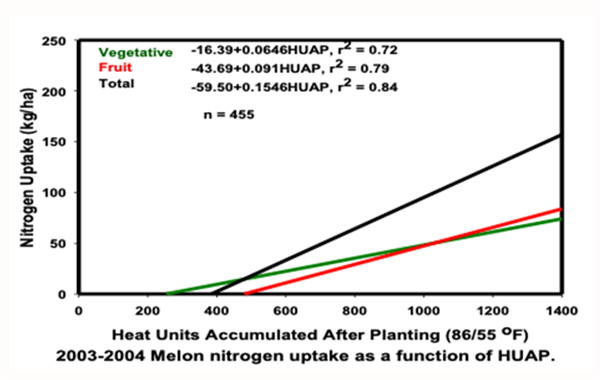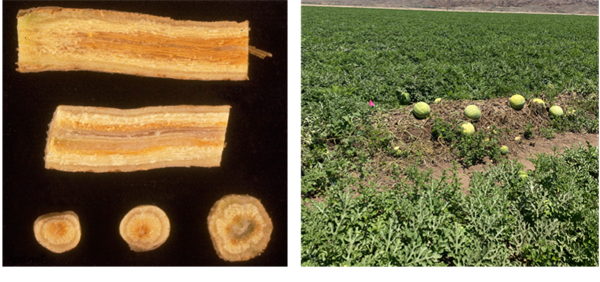Apr 19, 2023
Melon/Cantaloupe Crop Demand of Water and Nitrogen
All plants have distinct habits of growth and development as a function of time (phenology). Plant growth is a direct response to environmental conditions, particularly temperature and in some cases daylength. As a result, tracking plant growth and development as a function if temperature conditions is a much more reliable method than the calendar.
In a recent edition of this newsletter on 4 April 2023, I presented a cantaloupe phenological (crop growth and development) model based on heat units accumulated after planting (HUAP, 86/55 Fo thresholds) as shown in Figure 1.
Phenological models can serve as good tools for improving crop management (e.g., fertilization, irrigation, harvest scheduling, pest management activities, and labor, etc.) by identifying and predicting important stages of crop growth and development and harvest dates.
Included in our work with the development of this phenological model, we have also conducted nutrient uptake and water use studies to develop a better understanding of nutrient and water demand for desert cantaloupe production (Silvertooth, 2003; Soto et al., 2006; and Soto, 2012).
Figure 2 presents the nitrogen (N) uptake and portioning patterns for desert cantaloupes (melons), (Silvertooth, 2003 and Soto et al. 2006). The total N uptake for cantaloupes was found to be approximately 140 lbs. N/acre. The maximum N flux (N uptake/day) period extends from early fruit development (crown stage) to the netting stage.
Water use by desert cantaloupe production was also measured in these studies and patterns of water use followed the crop coefficient (Kc) patterns provided by the Arizona Meteorological Network (AZMET) and conformed to the Kc values from FAO 56 (Allen et al., 1998 and Grattan et al., 1998).
Considering N uptake and water demand patterns in relation to cantaloupe crop phenology, we can insert the overlaps as shown in Figure 1, with the red and blue lines for N and water management, respectively. Maximum N demand occurs from approximately 500 to 1,000 HUAP, which coincides with primary fruit development.
The N application window is recommended in advance of the optimum N uptake period to provide for N mineralization and the plant-available forms of N for plant uptake and utilization.
The N application window for optimum N uptake is from approximately 300 to 800 HUAP, which is from early flowering (crown blooms) to the netting stage of the crown fruit.
Early and split applications during the N application window of cantaloupe crop development can help achieve optimum utilization and higher efficiencies of fertilizer N inputs.
The period of maximum water demand extends from early fruiting stages of development through the maturation of the crown fruit, 300 to 1300 HUAP.
Considering the current water shortages and high prices of fertilizers, we have sufficient motivation to manage our crop production systems with the highest efficiency possible. Understanding crop water and nutrient demand for each crop we are working with and using that knowledge to manage our crops most effectively, is to our benefit agronomically, economically, and environmentally.
Nitrogen is the plant nutrient required in largest amounts by crops and it is important for us to manage N inputs for a crop in a careful and deliberate manner. Water and N interactions are a critical aspect of crop growth, development, and management in any system, but particularly in an irrigated crop production system.
I encourage those who are working with spring cantaloupe production this season to test and evaluate this crop phenology model, particularly in relation to nutrient and water management under field conditions with various planting dates, varieties, and soil types. We appreciate your feedback.
Note: Up to date weather data, including HU accumulations since 1 January can be found for all of the Arizona Meteorological Network (AZMET) locations at the following website: https://ag.arizona.edu/azmet/
References:
Grattan, S.R., W. Bowers, A. Dong, R.L. Snyder, J.J. Carroll, and W. George. 1998. New crop coefficients estimate water use of vegetables, row crops. California Agriculture 52(1):16-21. https://doi.org/10.3733/ca.v052n01p16
Allen, R.G., L.S. Pereira, D. Raes, and M. Smith. 1998. Crop evapotranspiration - Guidelines for computing crop water requirements - FAO Irrigation and drainage paper 56. Food and Agriculture Organization of the United Nations. Rome (FAO). https://www.fao.org/3/x0490e/x0490e0b.htm
Silvertooth, J.C. 2003. Nutrient uptake in irrigated cantaloupes. Annual meeting, ASA-CSSA-SSSA, Denver, CO.
Soto, R. O. 2012. Crop phenology and dry matter accumulation and portioning for irrigated spring cantaloupes in the desert Southwest. Ph.D. Dissertation, Department of Soil, Water and Environmental Science, University of Arizona.
Soto-Ortiz, R., J.C. Silvertooth, and A. Galadima. 2006. Nutrient uptake patterns in irrigated melons (Cucumis melo L.). Annual Meetings, ASA-CSSA-SSSA, Indianpolis, IN.

Figure 1. Heat Units Accumulated After Planting (HUAP,86/55 °F)

Figure 2. Cantaloupe (melon) N uptake and partitioning patterns. (Soto, Silvertooth,
and Galadima 2006). Note: kg/ha * 0.89 = lbs/acre
To contact Jeff Silvertooth go to:
silver@ag.arizona.edu









